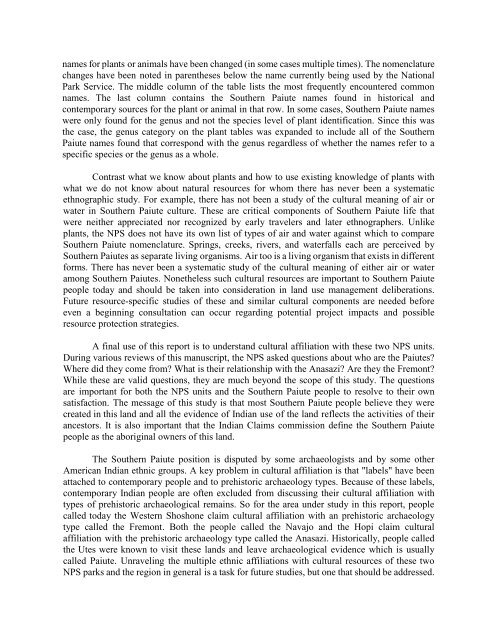Ethnographic Overview And Assessment: Zion National Park, Utah ...
Ethnographic Overview And Assessment: Zion National Park, Utah ...
Ethnographic Overview And Assessment: Zion National Park, Utah ...
Create successful ePaper yourself
Turn your PDF publications into a flip-book with our unique Google optimized e-Paper software.
names for plants or animals have been changed (in some cases multiple times). The nomenclature<br />
changes have been noted in parentheses below the name currently being used by the <strong>National</strong><br />
<strong>Park</strong> Service. The middle column of the table lists the most frequently encountered common<br />
names. The last column contains the Southern Paiute names found in historical and<br />
contemporary sources for the plant or animal in that row. In some cases, Southern Paiute names<br />
were only found for the genus and not the species level of plant identification. Since this was<br />
the case, the genus category on the plant tables was expanded to include all of the Southern<br />
Paiute names found that correspond with the genus regardless of whether the names refer to a<br />
specific species or the genus as a whole.<br />
Contrast what we know about plants and how to use existing knowledge of plants with<br />
what we do not know about natural resources for whom there has never been a systematic<br />
ethnographic study. For example, there has not been a study of the cultural meaning of air or<br />
water in Southern Paiute culture. These are critical components of Southern Paiute life that<br />
were neither appreciated nor recognized by early travelers and later ethnographers. Unlike<br />
plants, the NPS does not have its own list of types of air and water against which to compare<br />
Southern Paiute nomenclature. Springs, creeks, rivers, and waterfalls each are perceived by<br />
Southern Paiutes as separate living organisms. Air too is a living organism that exists in different<br />
forms. There has never been a systematic study of the cultural meaning of either air or water<br />
among Southern Paiutes. Nonetheless such cultural resources are important to Southern Paiute<br />
people today and should be taken into consideration in land use management deliberations.<br />
Future resource-specific studies of these and similar cultural components are needed before<br />
even a beginning consultation can occur regarding potential project impacts and possible<br />
resource protection strategies.<br />
A final use of this report is to understand cultural affiliation with these two NPS units.<br />
During various reviews of this manuscript, the NPS asked questions about who are the Paiutes?<br />
Where did they come from? What is their relationship with the Anasazi? Are they the Fremont?<br />
While these are valid questions, they are much beyond the scope of this study. The questions<br />
are important for both the NPS units and the Southern Paiute people to resolve to their own<br />
satisfaction. The message of this study is that most Southern Paiute people believe they were<br />
created in this land and all the evidence of Indian use of the land reflects the activities of their<br />
ancestors. It is also important that the Indian Claims commission define the Southern Paiute<br />
people as the aboriginal owners of this land.<br />
The Southern Paiute position is disputed by some archaeologists and by some other<br />
American Indian ethnic groups. A key problem in cultural affiliation is that "labels" have been<br />
attached to contemporary people and to prehistoric archaeology types. Because of these labels,<br />
contemporary Indian people are often excluded from discussing their cultural affiliation with<br />
types of prehistoric archaeological remains. So for the area under study in this report, people<br />
called today the Western Shoshone claim cultural affiliation with an prehistoric archaeology<br />
type called the Fremont. Both the people called the Navajo and the Hopi claim cultural<br />
affiliation with the prehistoric archaeology type called the Anasazi. Historically, people called<br />
the Utes were known to visit these lands and leave archaeological evidence which is usually<br />
called Paiute. Unraveling the multiple ethnic affiliations with cultural resources of these two<br />
NPS parks and the region in general is a task for future studies, but one that should be addressed.

















